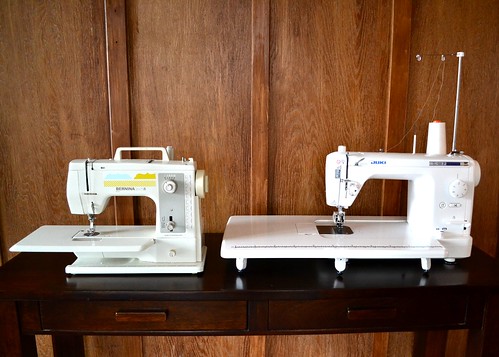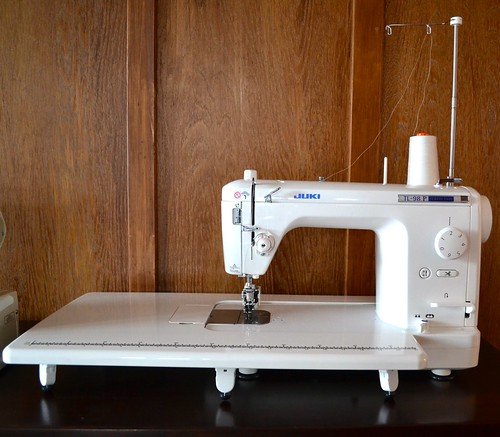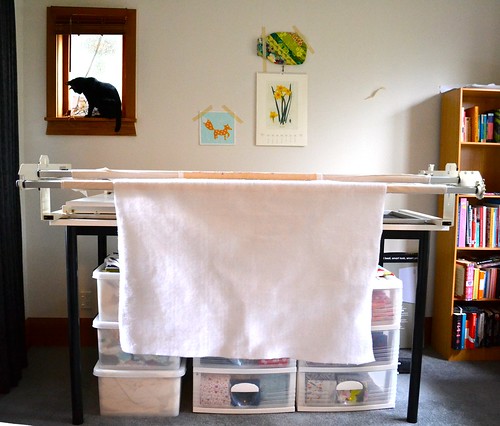A couple of months ago I bought a Juki TL-98P
sewing machine and Swiftquilter
quilting frame from Sew Frisco. In
the interests of full disclosure, I'll tell you now that I negotiated a discount
on the purchase price in exchange for blog advertising and a couple of blog post
reviews. This is the first one and I'll do another review at around the 6 month
mark. As with all my reviews, I agreed to this on the basis that my review
would be completely honest and mention any cons as well as pros.
So, how did I decide to buy the Juki? I decided I needed a new sewing machine and narrowed my choice of brands down to Bernina (because that's what I had already and what I've sewn on most before), Janome (because that's what most of my real life quilting friends have, and what lots of bloggers have and recommend) and Juki (because lots of bloggers have been raving about their Jukis and I really liked the idea of a fully mechanical sewing machine because I thrash my sewing machine and I don't want it to break down).
Then I started using my Mum's Bernina 440QE, which has a stitch regulator (BSR), for free motion quilting. BSR is really nice - it means that your stitches are a consistent length and it definitely helps when you're learning to free motion quilt. I got hooked, and started using Mum's sewing machine every time I needed to free motion quilt something. I decided that the BSR was so great that I HAD to get a Bernina, even though they are significantly more expensive than any other brand of machine.
To get the throat space I wanted with a Bernina, I needed to go up to the 700 series, so I started saving up for the Bernina 750QE, which retails in New Zealand for $6,999 (by comparison, a Janome 8900 QC retails in New Zealand for $5,499). (Yes, I cry a little bit inside every time I read American sewing machine prices). And then, I needed to do some free motion quilting and I didn't have time to go around and use Mum's sewing machine. So I used my little, basic, 25 year old Bernina which definitely does not have BSR. And do you know what? My stitches were still pretty consistent. I quilted a woodgrain pattern, which I hadn't done before, and I didn't have any issues with the quilting. My tension was perfect. All these things which I thought the BSR was doing for me, I was capable of doing myself. I didn't NEED BSR. I had just needed practice and the BSR gave me the ability do a nice job while I was still practising. (By the way, I don't think this is something unique to me. If you have BSR and always use it, try turning it off, just for a test. I think you might be surprised.)
That opened up the sewing machine options for me again. I was still interested in the Juki but unwilling to buy one sight unseen, and the only Juki dealer (Sew Frisco) is in Auckland. When I got sent to work in Auckland for a few weeks, I decided to take the opportunity to check out a Juki for myself. It was really really nice, and with a price of $1,995, seemed like great value for money compared to the other options.
Now, I will say in defence of the Bernina and Janome machines that they do much more than the Juki. The Juki is straight stitch only and the Bernina and Janome machines have all kinds of stitches, and you can do embroidery, and they are computerised and basically a whole bunch more sophisticated than the Juki. BUT, I don't use almost any of that stuff now and I couldn't see that I would use it in the future. Basically, to get the large throat space, you have to pay for a whole lot of other stuff that you may or may not use.
Now I've had the Juki for a few weeks, and I love it. I've used it on the quilting frame, for free motion quilting off the frame, for piecing, for straight line quilting, and to make a small bag (including installing a zip). It has handled all of those tasks really well and is basically a joy to use. By the way, as far as I can tell, the Juki TL-98P is exactly the same as the TL-98Q available in the US, except that it runs on New Zealand voltage. An equivalent to the Juki TL-2010Q isn't available here, but I think the only difference is that the TL-2010Q has a speed control and the TL-98 does not.
So I thought it would be interesting to go back to my post on the sewing machine I've been using for most of my quilting life, my Bernina 802 Sport. I made a bit of a shopping list of features I was looking for in my next machine:
- large throat space. Check - the Juki TL-98P has 9" of space between the needle and the right hand upright.
- automatic needle down. This is pretty much a given on all modern sewing machines, so of course the Juki has it. It's sooooo nice though!
- more speed. The Juki definitely delivers on this. I spent most of the time pedal to the metal on my Bernina, but I haven't even touched the top speed on the Juki yet. From a technical perspective, it does 1500 stitches per minute. I can confirm that it is FAST.
- knee lift. The Juki has a knee lift which works really well and even clips into the extension table when you're not using it.
One feature which wasn't on my wish list but which I really really love is the automatic thread cutter - you either hit a button on the machine or on the foot pedal and it cuts your thread for you. Awesome.
There are a couple of downsides to the Juki:
- the Juki only does one thing, straight stitch, but it does it super well. If you are looking for a general purpose domestic sewing machine, this is not the one for you. It doesn't have a zig zag stitch for sewing knits, or a blanket stitch for machine appliqué, or anything like that. I'd say it's best suited to a quilter who already has one sewing machine and is looking to upgrade and get more throat space. I was planning to keep my Bernina anyway, and I'll be using it whenever I need a zigzag stitch (I like to finish the inside seams of cushions and bags this way for durability).
- the Juki does not have a free arm. Apart from the lack of zigzag stitch, this makes it unsuitable for sewing most garments. It also means you'll be going back to your domestic machine for some tasks, like top-stitching around the edge of a small zipper pouch, for example.
- as far as I've been able to tell, you can't get an open toe foot for the Juki. It would most commonly be used for non straight stitching anyway, so that makes sense, but there are times when it's nice to have a good view of the needle, like when you're sewing on the line for foundation paper piecing, or sewing on a marked line when you're quilting. I'm going to investigate whether I can get a generic open toe foot that works on the Juki.
- it's a big heavy (11.5kg/25lb) sewing machine. That makes it awesome to sew on but not terribly portable. It also doesn't come with a hard cover or travel case (but of course you could buy a generic sewing machine bag if you wanted).
None of these are things which put me off the Juki or mean that I'm disappointed in it. I just wanted to be clear that it does what it does, and it does it very well, but it doesn't do everything.
I've used the Juki with Aurifil (it takes a cone, yay) and with Guterman cotton quilting thread and it's handled both of them perfectly. For free motion quilting I've stuck to the 90/14 and 100/16 Organ needles that came with the machine, but for piecing I've used Schmetz 80/12 Microtex Sharp needles with great success. I'll continue to experiment with different needles for different applications, but when I'm using the Juki on the Swiftquilter frame, I've discovered that I really do need to stick with the heavier 100/16 needles (after breaking two 90/14 needles in quick succession).
So far I've pretty much stuck to a description of the sewing machine as used in the way that most people would use it - without the Swiftquilter frame. Even if you're not interested in a frame, it's still a really great machine and I would definitely recommend it.
So, the Swiftquilter frame. Basically, it's a set up which includes a moving platform that you sit the sewing machine on, a frame with leaders and enders to stretch the quilt out on, so you free motion quilt by moving the sewing machine and not the quilt. I bought it because I find normal free motion quilting, where you move the quilt under the needle, very hard on my hands, my neck and my shoulders. I want to do more free motion quilting but I don't because I can't spend too much time doing it or I end up unable to turn my head.
You sit the frame on a table (I had a special extra tall one made so that the controls are at a comfortable height to use when standing and also so I can see where I'm stitching. The optimal height for your table will depend on your height.) The basic frame is 72" wide, and the bit that sits on the table is 23" deep. The frame overhangs the table so in total it is 34" deep. The highest point of the frame will sit 11" above the table top, and the part which the quilt sits on is 8" above the table top. Even though the basic frame is 72" wide, really the widest quilt you can quilt on it is 50" wide. That's because you need extra room at the sides for the platform that the sewing machine sits on.
The frame also comes with an extension, which takes its total width out to 108". I haven't used the extension yet (and to be honest I'll need to measure to check that my sewing room is even 108" wide!) but hopefully I'll have given it a try by the time my next review rolls around.
I really like the way the platform that the sewing machine sits on moves. It moves smoothly and freely, but it's got a bit of weight to it (mostly the sewing machine, I guess), which makes it easier (for me, anyway), than something which moves really really easily (I've used long-arms which move at the slightest touch and I found them really hard to control).
I found the frame easy to assemble with the help of the assembly video on Sew Frisco's website. I did it by myself so it's not like its a two person job or anything like that. I do quite enjoy assembling flat pack furniture though, so if you absolutely hate things like that you may not enjoy putting the frame together but I still don't think you'd find it difficult. I know some people disassemble their frames and put them away when they're not using them, but I'm leaving mine up all the time.
The frame can conceptually be used with any large throat sewing machine, but it's recommended for use with Juki TL-98P. As you'll see if you watch the video, it comes with a handle that screws onto the machine which has controls which plug in so you can control the machine from the handle (no foot pedal needed).
With a lot of help from my sister, I made a video which explains how I load a quilt onto the frame and set it up for quilting. Hopefully it will give you a good sense of how the frame works, because it would be quite hard to describe in a meaningful way in writing.
Disclaimer: I take no responsibility for the
actions of my eyebrows in this video!
Ok well I hope you enjoyed the video (or at least had a good laugh)!
If there is anything else you want to know about the Juki and/or the Swiftquilter, let me know and I'll try to answer your question.





No comments:
Post a Comment